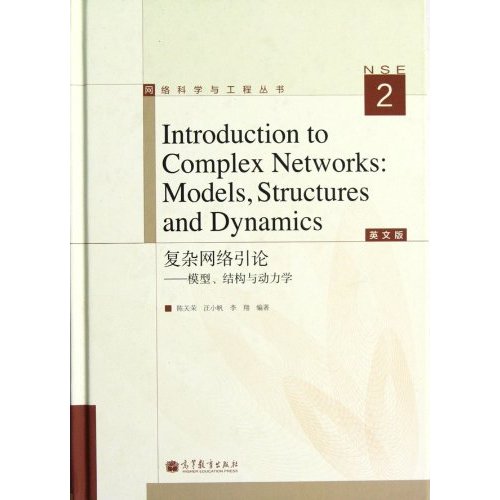《複雜網路引論》是2012年5月由高等教育出版社出版的圖書,作者是陳關榮。
基本介紹
- 書名:複雜網路引論
- 作者:陳關榮
- ISBN:9787040347821
- 頁數:332
- 定價:79.00元
- 出版社:高等教育出版社
- 出版時間:2012-5
- 副標題:模型、結構與動力學
內容簡介,作者簡介,目錄,
內容簡介
《複雜網路引論:模型、結構與動力學(英文版)》力求正確和準確,但並不刻意採取十分嚴謹的寫法,以期通俗易懂,側重於主要思想和基本方法的介紹,僅提供啟發性的數學支撐,希望具有初等微積分、線性代數和常微分方程的讀者能夠輕鬆地學習書中的主要內容。《複雜網路引論:模型、結構與動力學(英文版)》分成兩大部分:第一部分是基礎理論,包括背景材料和信息並附有適量的練習題,旨在讓讀者熟悉一些最基本的建模方法和分析技巧。第二部分是套用選題,包括複雜網路在幾個代表性領域巾的套用研究,這些章節彼此相對獨立。最後一章是近年來比較活躍的幾個前沿研究課題的簡介。各章均附有詳細的關鍵文獻,希望能夠幫助有興趣的讀者很快地進入這些研究領域。
作者簡介
陳關榮,1981年獲中山大學計算數學碩士學位,1987年獲美國德克薩斯A&M大學套用數學博士學位。於休斯頓大學任教至2000年,現任香港城市大學電子工程系講座教授。1996年當選為IEEE Fellow。獲2008年國家自然科學二等獎、2010年何梁何利獎、201 1年俄羅斯歐拉獎並獲俄羅斯聖彼得堡國立大學榮譽博士學位,獲4項IEEE等最佳學術雜誌論文獎,是國內外30多所大學的榮譽或客座教授。現任International Journal of Bifurcation and Chaos主編,SCI他引一萬六千多次,h指數62,被ISI評定為工程學高引用率研究人員。
汪小帆,1996年獲東南大學工學博士學位。現為上海交通大學電子信息與電氣工程學院教授、致遠學院常務副院長。2008年受聘為教育部長江學者特聘教授。近年一直從事複雜網路系統分析與控制研究。獲2002年國家傑出青年科學基金、2005年IEEE電路與系統彙刊最佳論文獎、2008年上海市自然科學一等獎和2010年上海市自然科學牡丹獎。
李翔,2002年獲南開大學工學博士學位。現為復旦大學信息科學與工程學院教授、電子工程系主任。近年一直從事複雜網路系統控制的理論與套用研究。獲2005年IEEE電路與系統彙刊最佳論文獎、2008年上海市自然科學一等獎、2010年上海市青年科技英才獎和2011年霍英東教育基金會高等院校青年教師獎,2009年入選教育部新世紀優秀人才計畫。
汪小帆,1996年獲東南大學工學博士學位。現為上海交通大學電子信息與電氣工程學院教授、致遠學院常務副院長。2008年受聘為教育部長江學者特聘教授。近年一直從事複雜網路系統分析與控制研究。獲2002年國家傑出青年科學基金、2005年IEEE電路與系統彙刊最佳論文獎、2008年上海市自然科學一等獎和2010年上海市自然科學牡丹獎。
李翔,2002年獲南開大學工學博士學位。現為復旦大學信息科學與工程學院教授、電子工程系主任。近年一直從事複雜網路系統控制的理論與套用研究。獲2005年IEEE電路與系統彙刊最佳論文獎、2008年上海市自然科學一等獎、2010年上海市青年科技英才獎和2011年霍英東教育基金會高等院校青年教師獎,2009年入選教育部新世紀優秀人才計畫。
目錄
Part I Fundamental Theory
Chapter 1 Introduction
1.1 Background and Motivation
1.2 A Brief History of Complex Network Research
1.2.1 The Konigsburg Seven-Bridge Problem
1.2.2 Random Graph Theory
1.2.3 Small-World Experiment
1.2.4 Strength of Weak Ties
1.2.5New Era of Complex-Network Studies
1.3 Some Basic Concepts
1.3.1 Graph Representation of Networks
1.3.2 Average Path Length
1.3.3 Clustering Coefficient
1.3.4 Degree and Degree Distribution
1.3.5 Statistical Properties of Some Real-World Complex Networks
Problems
References
Chapter 2A Brief Introduction to Graph Theory
2.1 What is a Graph?
2.2 Notation, Definitions and Preliminaries
2.3 Eulerian and Hamiltonian Graphs
2.3.1 Eulerian Graphs
2.3.2 Hamiltonian Graphs
2.4The Chinese Postman Problem
2.5 The Shortest Path Length Problem
2.6 Trees
2.7 The Minimum Connector Problem
2.8 Plane Graphs and Planar Graphs
2.9 Euler Formula for Plane Graphs
2.10 Directed Graphs
Problems
References
Chapter 3 Network Topologies: Basic Models and Properties
3.1 Introduction
3.2 Regular Networks
3.3 Random-Graph Networks
3.4 Small-World Network Models
3.4.1 The WS Small-World Network Model
3.4.2 The NW Small-World Network Model
3.4.3 Statistical Properties of Small-World Network Models
3.5 The Navigable Small-World Network Model
3.6 Scale-Free Network Models
3.6.1 The BA Scale-Free Network Model
3.6.2 Robustness versus Fragility
3.6.3 Modified BA Models
3.6.4 A Simple Model with Power-Law Degree Distribution
3.6.5 Local-World and Multi-Local-World Network Models
Problems
References
Part II Applications: Selected Topics
Chapter 4 Internet: Topology and Modeling
4.1 Introduction
4.2 Topological Properties of the Internet
4.2.1 Power-Law Node-Degree Distributions
4.2.2 Hierarchical Structures
4.2.3 Rich-Club Structure
4.2.4 Disassortative Property
4.2.5 Coreness and Betweenness
4.2.6 Growth of the Internet
4.2.7 Router-Levellnternet Topology
4.2.8 Geographic Layout of the Internet
4.3 Random-Graph Network Topology Generator
4.4 Structural Network Topology Generators
4.4.1 Tiers Topology Generator
……
Index
Chapter 1 Introduction
1.1 Background and Motivation
1.2 A Brief History of Complex Network Research
1.2.1 The Konigsburg Seven-Bridge Problem
1.2.2 Random Graph Theory
1.2.3 Small-World Experiment
1.2.4 Strength of Weak Ties
1.2.5New Era of Complex-Network Studies
1.3 Some Basic Concepts
1.3.1 Graph Representation of Networks
1.3.2 Average Path Length
1.3.3 Clustering Coefficient
1.3.4 Degree and Degree Distribution
1.3.5 Statistical Properties of Some Real-World Complex Networks
Problems
References
Chapter 2A Brief Introduction to Graph Theory
2.1 What is a Graph?
2.2 Notation, Definitions and Preliminaries
2.3 Eulerian and Hamiltonian Graphs
2.3.1 Eulerian Graphs
2.3.2 Hamiltonian Graphs
2.4The Chinese Postman Problem
2.5 The Shortest Path Length Problem
2.6 Trees
2.7 The Minimum Connector Problem
2.8 Plane Graphs and Planar Graphs
2.9 Euler Formula for Plane Graphs
2.10 Directed Graphs
Problems
References
Chapter 3 Network Topologies: Basic Models and Properties
3.1 Introduction
3.2 Regular Networks
3.3 Random-Graph Networks
3.4 Small-World Network Models
3.4.1 The WS Small-World Network Model
3.4.2 The NW Small-World Network Model
3.4.3 Statistical Properties of Small-World Network Models
3.5 The Navigable Small-World Network Model
3.6 Scale-Free Network Models
3.6.1 The BA Scale-Free Network Model
3.6.2 Robustness versus Fragility
3.6.3 Modified BA Models
3.6.4 A Simple Model with Power-Law Degree Distribution
3.6.5 Local-World and Multi-Local-World Network Models
Problems
References
Part II Applications: Selected Topics
Chapter 4 Internet: Topology and Modeling
4.1 Introduction
4.2 Topological Properties of the Internet
4.2.1 Power-Law Node-Degree Distributions
4.2.2 Hierarchical Structures
4.2.3 Rich-Club Structure
4.2.4 Disassortative Property
4.2.5 Coreness and Betweenness
4.2.6 Growth of the Internet
4.2.7 Router-Levellnternet Topology
4.2.8 Geographic Layout of the Internet
4.3 Random-Graph Network Topology Generator
4.4 Structural Network Topology Generators
4.4.1 Tiers Topology Generator
……
Index

